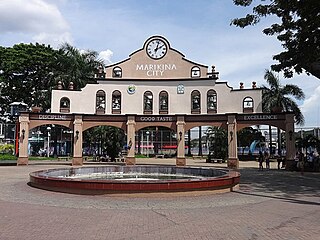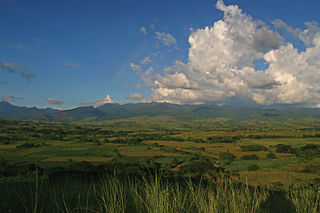
Cotabato City, officially known as the City of Cotabato, is a 3rd class independent component city in the Bangsamoro Autonomous Region in Muslim Mindanao, Philippines. According to the 2020 census, it has a population of 325,079 people, making it as the most populated city under the independent component city status.

Marikina, officially known as the City of Marikina, is a 1st class highly urbanized city in the National Capital Region of the Philippines. According to the 2020 census, it has a population of 456,059 people.

Dipolog, officially known as the City of Dipolog, is a 3rd class component city and capital of the province of Zamboanga del Norte, Philippines. According to the 2020 census, it has a population of 138,141 people.

Caloocan, officially known as the City of Caloocan, is a 1st class highly urbanized city in Metropolitan Manila, Philippines. According to the 2020 census, it has a population of 1,661,584 people making it the fourth-most populous city in the Philippines.

Dasmariñas, officially known as the City of Dasmariñas, often shortened to Dasma, is a 1st class component city in the province of Cavite, Philippines.

Bay, officially the Municipality of Bay, is a 2nd class municipality in the province of Laguna, Philippines. According to the 2020 census, it has a population of 67,182 people.

Pagadian, officially known as the City of Pagadian, is a 2nd class component city and the capital of the province of Zamboanga del Sur, Philippines. It is the regional center of Zamboanga Peninsula and the second-largest city in the region and in the province, after the independent city of Zamboanga. According to the 2020 census, it has a population of 210,452 people. The city will be converted to a highly-urbanized city by the virtue of Proclamation No. 1247, signed by President Rodrigo Duterte dated November 8, 2021, but shall take effect after the ratification in a plebiscite.

Lucena, officially known as the City of Lucena, is a 1st class highly urbanized city in the Calabarzon region of the Philippines. It is the capital city of the province of Quezon where it is geographically situated but, in terms of government and administration, the city is politically independent from the province. For statistical and geographical purposes, Lucena is grouped with the province of Quezon. According to the 2020 census, it has a population of 278,924 people.

San Nicolas, officially the Municipality of San Nicolas, is a 2nd class municipality in the province of Ilocos Norte, Philippines. According to the 2020 census, it has a population of 38,895 people.

Cabagan, officially the Municipality of Cabagan, is a 1st class municipality in the province of Isabela, Philippines. According to the 2020 census, it has a population of 53,897 people.

Liloy, officially the Municipality of Liloy, is a 3rd class municipality in the province of Zamboanga del Norte, Philippines. According to the 2020 census, it has a population of 42,213 people.

Sindangan, officially the Municipality of Sindangan, is a 1st class municipality in the province of Zamboanga del Norte, Philippines. According to the 2020 census, it has a population of 103,952 people.

Valencia, officially known as the City of Valencia, is a 2nd class component city in the province of Bukidnon, Philippines. According to the 2020 census, it has a population of 216,546 people.

Dinas, officially the Municipality of Dinas, is a 4th class municipality in the province of Zamboanga del Sur, Philippines. According to the 2020 census, it has a population of 36,291 people.

Bayog, officially the Municipality of Bayog, is a 3rd class municipality in the province of Zamboanga del Sur, Philippines. According to the 2020 census, it has a population of 34,519 people.

Molave, officially known as the Municipality of Molave, is a 1st class municipality in the province of Zamboanga del Sur, Philippines. In the 2020 census, it had 53,140 people. It is in the eastern part of the province of Zamboanga del Sur, and has an area of 21,685 hectares. The name "Molave" refers to the tree that was common in the area. Its economy is focused on agricultural production, and 1,378.5 hectares of fertile land is irrigated and planted with rice. Corn, coconut, cassava, banana, camote and various vegetables are also grown. These are marketed to neighboring towns and cities, and reach Cebu. Due to its strategic location, Molave is becoming the commercial hub of the Salug Valley.

Tukuran, officially the Municipality of Tukuran, is a 4th class municipality in the province of Zamboanga del Sur, Philippines. According to the 2020 census, it has a population of 42,429 people.

Zamboanga City, officially known as the City of Zamboanga, is a city in the Zamboanga Peninsula region of the Philippines. According to the 2020 census, it has a population of 977,234 people. It is the fifth-most populous and third-largest city by land area in the Philippines. It is the commercial and industrial center of the Zamboanga Peninsula Region.
Barangay de Ayala, or more commonly Ayala, is one of the 98 barangays in Zamboanga City. It is located 16.5 kilometers west of the city proper and is easily accessible by land and sea. Generally regarded by Zamboangueños as one of the most developed barrios in the west coast, Ayala spans 5.29 square kilometers wide and houses several canning factories.


















